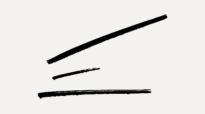From grad to gig: The job search

Figuring out your vision for the future is one beast, but actually presenting your work and reaching out to potential employers about opportunities is a whole other ball game!
In this week's series instalment, we're detailing a variety of tips and tricks for getting your foot in the door, making cold-calls or emails and presenting yourself successfully.
Potential employers take note when you're self-assured.
If you have the ability to introduce yourself well, express a clear interest in our work and why you'd like to connect, we'll start to think, “Hey, this is a person I could put in front of a client. This is someone who can present work, talk about themselves, grab someone's attention and move the conversation forward.”
— Chris Govias, Chief of Design at The Canadian Digital Service in Ottawa
Be specific with your questions.
When emailing someone about or meeting someone for an informational interview, have questions for them. It's really difficult to give people general advice. The more specific you are, the more helpful we can be.
— Berkeley Poole, Creative Director at Whitman Emorson in Toronto
Sharing your perspective is encouraged.
If you're asking someone for a portfolio review or informational interview, or if you're in a job interview, it's valuable to share how you feel about their work. It builds a connection and shows that you're actually interested and invested in what they're doing as a designer.
— Robyn Cambruzzi, Associate Creative Director of Design Mosaic North America in Toronto
Be analytical with your portfolio's presentation...
When putting your portfolio together, ask yourself, “What is this authentically saying about me? What would a person think when they see this book?”. It's really important to take an analytical approach to how much you share and include in your portfolio.
— Eleni Alpous, Manager, Design & Insights at Doblin in Toronto
... but make sure your portfolio also communicates your passion.
I always see portfolios filled with school work, which is great. But if there are other areas of design or creativity that you're passionate about, I want to see it. Create a project and include it. I want to see your talent, and that shines through when you're passionate about your work.
— Vanessa Eckstein RGD, Founder & Creative Director of Blok Design in Toronto
Humility is an essential attribute.
Ego, entitlement and the belief that you deserve a position is a major turn-off for us. You have to be humble and you have to be collaborative. I make as much coffee as anyone else on our team, and that willingness to work together needs to be present in everyone.
— Nick Richards, Founder & Executive Creative Director of Will in Vancouver
Demonstrate how you can be adaptable.
We like to see flexibility in our team. It's really important for everyone to offer ideas, but also to not hold on to them so tightly that you can't let them go. Depending on what feedback comes back from the client or the user, you'll need to change and adapt your design. Having that ability to adapt is key.
— Julie Barge RGD, Manager of Visual Design at Canada Life in London, Ontario
Ask for insight on how you can keep growing as a designer.
When it comes time for questions in an interview, it's great when people, especially students right out of school, ask how they can push themselves. Your experience is likely only student work, so asking for their opinion on what things you should be working on shows that you're wanting to grow and expand your skills.
— Geoff Lee, Director, Design and Brand at Bell Media Agency in Toronto
Tag
Related Articles


Ann Donar RGD, Sharon Lockwood RGD, Sarah Prouse RGD













